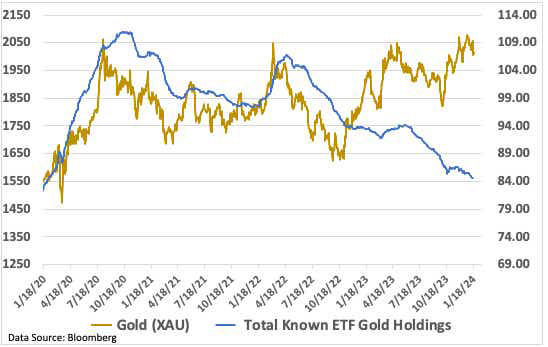Send this article to a friend:
January
22
2024
Send this article to a friend: January |
Gold ETF Outflows Have Dented the Outlook, but is a Turnaround in View?
Gold futures(/GCG4) are off to a poor start in 2024, dropping over 2.5% through Jan. 18 to the lowest levels traded since early December. A readjustment in market-based bets on when the Federal Reserve will start cutting interest rates has pushed bond yields and the dollar higher, strengthening headwinds for precious metal demand. Even growing geopolitical tensions are failing to underpin prices. Retail investors turn sour on gold ETFs Exchange-traded funds (ETFs) backed by physical gold tell a similar story. These ETFs make up a considerable part of the global gold market and are one of the preferred ways for retail investors to gain exposure to the metal. The SPDR Gold Trust (GLD) is down 2.2% on a month-to-date basis, although the ETF does remain near all-time highs. You would think that having one of the largest gold ETFs near all-time highs would stoke some excitement across the gold ETF market. However, that excitement is nowhere to be found for gold-backed ETF holdings in total. In fact, total known ETF gold holdings are at the lowest level since February 2020. Moreover, the chart below displays the steady decline in gold ETF holdings since late 2020. That trend has continued over the last year even as gold prices rose, as displayed by the chart.  Will investors return to gold ETFs? While the price of gold ETFs have increased because of the underlying rise in gold prices, the lack of enthusiasm speaks to the overarching theme that is dissuading risk in the market. It’s not that gold is a risky investment. Quite the contrary, but investors seem keen to stay cash heavy for now—likely because of uncertainty over the Fed’s rate cut path. Higher interest rates over the last few years have incentivized investors to hold cash, mostly in the form of money market funds, CDs and bonds. According to data from the Investment Company Institute, money mark fund assets totaled nearly $6 trillion as of Jan. 10—the highest on record by far. Where will this cash go when the Federal Reserve starts to cut rates? A lot of it likely won’t remain in money market funds because as the Fed cuts rates, the interest offered on those funds will decrease. Stock market bulls are optimistic that it will flow into equity markets, which a lot of it likely will. Some of it will also flow into gold prices, with gold-backed ETFs offering a venue for that cash. If investors return to those ETFs, it could help push gold futures prices higher, as fund managers move to purchase additional gold. For now, the market sees the first Fed cut happening in May. We’ll have to wait a few months, but gold prices may rip higher on the first Fed cut.
|
Send this article to a friend:
 |
 |
 |